![]()
Chinese Photographs
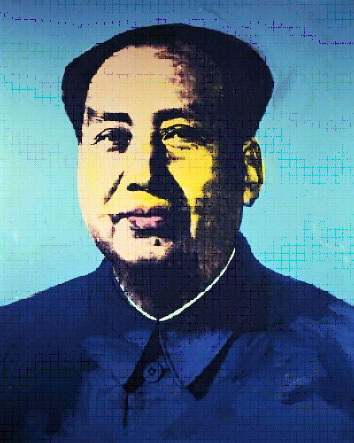
(Associated Press via International Herald Tribune) Warhol's 'Mao' portrait sells for record $17.4 million. November 16, 2006.
Andy Warhol's iconic image of Communist Party Chairman Mao Zedong, considered one of his most sensational pieces of the 1970s, sold for US$17.4 million, a world auction record for the artist, Christie's auction house said. The portrait was offered by the Swiss-based Daros Collection, owner of one of the greatest private holdings of Warhol paintings, and was sold on Wednesday to Hong Kong real estate tycoon and socialite Joseph Lau. It brought in about $5 million more than expected, Christie's said. The silk-screen portrait, measuring 81 inches by 61 inches (205 by 155 centimeters) and showing Mao in a dark blue jacket against a light blue background, was part of the auction house's evening sale of postwar and contemporary art.
That's interesting, but this piece of news does not generate much interest within mainland China. After all, it is the work of a foreign artist being auction overseas and then purchased by a Hong Kong tycoon.
More illuminating about Chinese society is an upcoming auction of photographs in China. There won't be photographs sold for millions of American dollars. Instead, the top-rated photograph will have a minimum bidding price of 240,000 RMB. We should consider that in the history of China over the past hundred years or so, there must have been billions of photographs taken. So why did this couple of hundred photographs get chosen in this auction?
To begin with, the choice had been made by a self-chosen cultural elite. They decided that which of the photographs were worth money. What was the basis? As you go through the photographs, you will realize that many of the photographs have been seen by hundreds of millions of people already, either as street posters or as photographs on the walls of their own homes. So how can another copy of the photograph be worth hundreds of thousands in RMB? This auction covers the limited original prints, which were valuable precisely because the copies had been seen by hundreds of millions. In that sense, this auction is just as much about artistic value as social impact. And that would make it very different from the Andy Warhol portrait of Chairman Mao.
Here is a selection of the photographs in the auction (via CNarts.net) with explanations.

Xie Hailong (解海龙)'s
<Big Eyes> is the symbol for Project Hope and is regarded as one of the
most important documentary photography in Chinese history. The photograph
has been widely carried by the media. The photograph shows a plain and
lovely little girl staring ahead with big eyes at something not shown in the
photograph, and that just be be "hope." By carrying out the
basic duty of a photograph, Xie Hailong has managed to move the entire society
to pay attention to the serious problem of poor educational opportunities in
rural areas. For more, please read Big
Eyes' Hope.
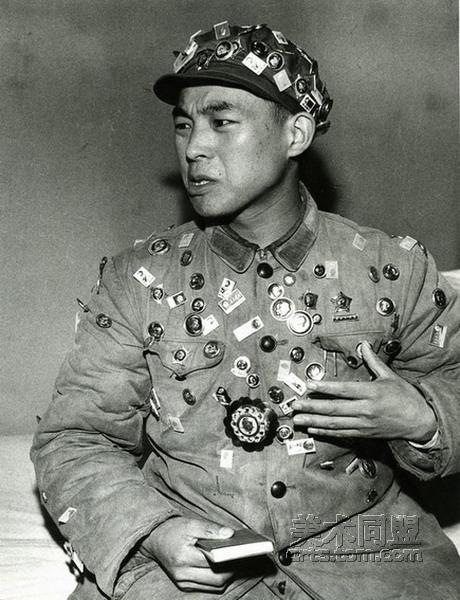
Li Zhencheng (李振盛)
is the first Chinese photographer whose work was used on the front cover of
TIME. His represenstative work is <The Believer> which is a
classical work that has appeared many times all over the world. The
auction will involve the only copy of the photograph left after the first rush
print.
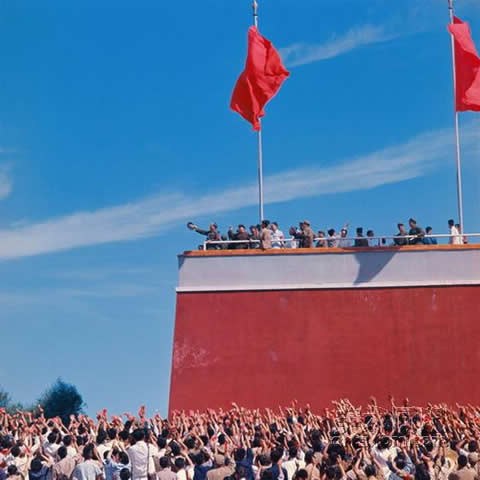
Weng Naiqiang (翁乃强)'s
<Waving Back> showed the masses of Red Guards waving their precious little
red books and surging forward like waves in the oceans. Meanwhile, the
unique angle made the Tiananmen building stand out like the brow of a ship at
the head of which Mao Zedong stood like a helmsman, waving to the Red Guards
with his cap. The dedication and the passion, the purity and the
enthusiasm, the oppression and the impulse, the silence and the violence ...
they showed the special atmosphere, sounds, tones and colors of that era.
This work has a powerful visual force that touches the strings in the heart.
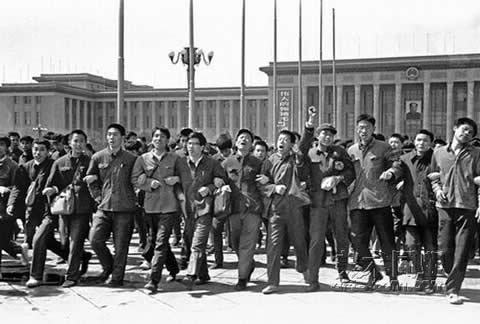
Wu Peng (吴鹏)
took <United Together To Wait For Tomorrow> at the April Fifth movement of
the 1976 Tiananmen Square incident. He took this photograph at grave
personal risk on the day when the Gang of Four suppressed the crowds. The
photograph shows a group of people marching arm in arm from the east side of the
National People's Congress towards the center of Tiananmen Square. This
photograph seemed to be the only one that survived from that bloody day.
As time progresses, the collector value of this photographs has increased.
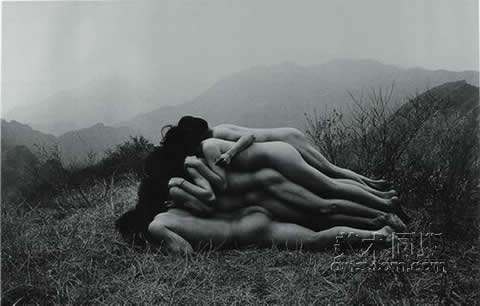
Zhu Ming (朱冥)
was an independent performance artist from the East Village of Beijing. In
1995, he took the photograph <Increasing The Nameless Hill By Another
Meter>. The photograph showed eleven totally nude men and women with
their bodies stacked one meter high on top of a nameless hill. This
rearranged the relations between human and human, human and nature as well as
man and woman in a new light and gave a Chinese flavor to body art where none
existed previously.
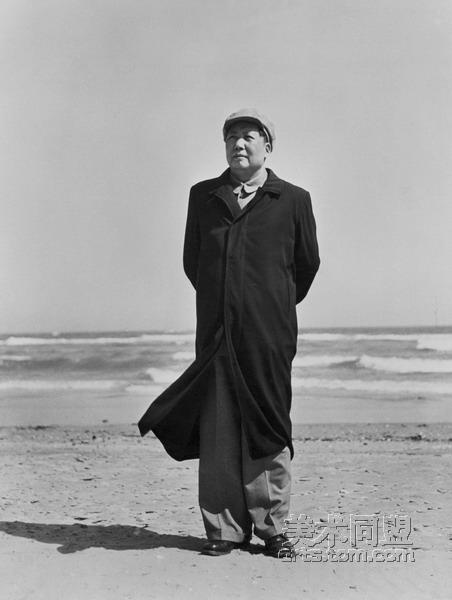
Hou Bo (侯波 )
was Chairman Mao's official photographer. In her <Mao Zedong at
Beidahe>, Chairman Mao wore a cap and a blue coat as he stood by the
seashore. Behind him, the ocean waves roared. The chairman's coat is
moving slightly in the wind. This classical image became an icon of
devotion in the homes of millions and is deeply embedded in the memories of the
people.
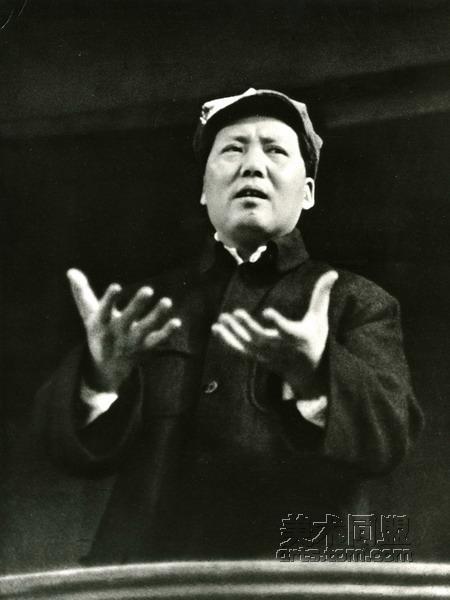
Wu Yinxian (吴印咸)
took many precious photographs of the Chinese Communist leaders during the Yenan
period. In <Mao Zedong in Yenan>, the photograph recorded Mao Zedong
giving a speech at a meeting to praise model laborers in the Shaanxi-Ganning
area in 1952. This photograph was taken with a roll of Japanese film that
was four years past its expiration date, and it is Wu Yinxian's favorite
photograph of his career.

Xiao Zhuang (晓庄)'s
photographs have very simple and plain appearances, but they include some dark
humor. In the photographs, the people are completely detached from the
actions. They seemed to be unaware of the stupidity and they do everything
with sincerity, energy and effort. People who have lived through that era
can hear the meaningless slogans and songs by looking at the photograph.
It is so close and yet so faraway, and it rends the heart apart. In front
of this photograph, any normal person would reflect on that historical episode
-- those who went through it are ashamed and those who came later should take
caution. People should get nervous and promise: We must never let this
moment recur in our motherland! Nobody has the right to let the people go
through this sort of pain and stupidity!
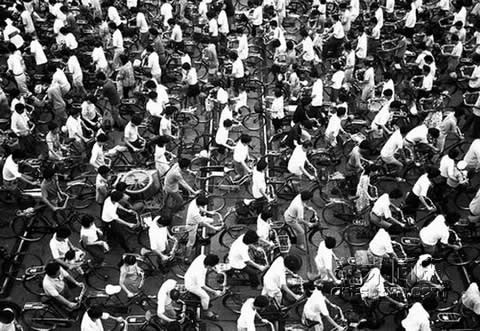
Wang Wenlan (王文澜)'s <The Kingdom of Bicycles>. During the peak commute hours, uncountable number of bicycles flowed from the hutongs into the main streets as they move like a huge river across the bridges. This great wall in motion must be one of the wonders of the world! If you are in the middle of it, you can feel that you are moving in a bloodstream -- it is warm, it is noisy, it contains endless potential, as if bicycles have soul, pulse and breath. China is a nation on two wheels.